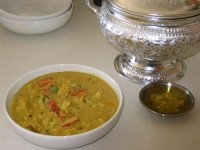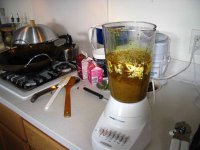Khurma

I adapted this recipe from one I found on the Internet in a chat between two unnamed parties, and from another given to me out of a magazine by a Mexican chef in the cafeteria at my work. I have added to the ingredient list in imitation of the khurma served at my local restaurant, Bombay House, which is delicious and which is the inspiration for attempting to cook Indian.
Also, I have altered the steps of the original recipes so that a) I could make a vegetarian dish if needed and b) to protect the cream and yogurt against the harm of being too long over the heat. Because of the presence of tumeric, this recipe’s color is the bright yellow of my local restaurant khurma and it is just as delicious. This khurma is on the sweet side though there is no sugar in the recipe.
Ingredients marked with an asterisk are those unlikely to be found outside an Indian specialty store. Some may be found in pre-ground form in American supermarkets, however, even recently purchased grinds will have lost their savor. The quality of the ingredients is pretty crucial; attempting this recipe without it may lead to disappointing results. It’s the difference between shaking a store-bought can of curry powder into a dish and going to your local restaurant: the taste is worlds apart. So, don’t cheat.
Ingredients may be reduced to powder using either a mortar and pestle or a small coffee grinder. As measured here, the ingredients are not overly strong. Increasing the proportions of this or that spice will intensify the flavors you prefer. I would suggest adding 25% more of most spices if you are squeamish about going over the top.
The spicyness of this dish is controlled by adding chilies. Anaheim chilies will make for a mild dish; in fact, when I want mild, I don’t even put them in. Jalapeños, serranos or Thai chilies will make it hot.
This recipe may be made with cream to enrich it (as is often done in restaurants. Be sure not to allow the cream to become denatured or curdled by heating too long.
For coconut khurma, replace some of the cream with coconut milk (I use about ½ of a 19-oz can) or coconut powder.
Yield
Serves 8-12.
Ingredients
| 4 tbsp | olive or vegetable oil | |
| 4 tbsp | ghee or vegetable oil | |
| — | water | |
| Aromates | ||
| — | green chilis (jalapeño, serrano, etc.) | |
| 3 | large onions, finely chopped | |
| 1½ tsp | ginger root, fresh minced | |
| 2 tsp | garlic, minced | |
| 1 can | chopped tomatoes (14 oz) and juice, puréed | |
| 1 tsp | kosher salt | |
| 1 tsp | ground pepper | |
| Spices | ||
| 1½ tsp | cumin seeds, finely powdered* | |
| 1 tsp | coriander seeds, finely powdered* | |
| 6 | green cardamom pods, husks removed, seeds powdered* | |
| 1 stick | cinnamon, freshly ground | |
| 3 tsp | garam masala* | |
| 1 tsp | ground tumeric | |
| Liquid ingredients | ||
| 1-2 cups | plain, unsweetened yogurt | |
| 2 cups | water, cream and/or coconut milk | |
| Garnishing ingredients | ||
| — | chicken or lamb, cauliflower florets, potatoes, spinach, etc. for 8-12 persons, precooked (blanched) | |
| 2-3 | medium Roma tomatoes, coarse-diced | |
| — | cashews | |
| — | golden raisins | |
| — | fresh cilantro leaves | |
Preparation
—In the interest of time (because what takes longest is the mise en place of the spices, I think that many steps steps may be done ahead of time, perhaps the night before, and the result refrigerated.

1. Prepare aromates. Clarify the onions plus the ginger root and garlic. Add the tomatoes. Simmer, adding water to ensure it doesn’t burn, for 20 minutes. Purée well in a blender adding yoghurt or cream if necessary. The result should be absolutely smooth (and muddy).
2. Roast the whole seed spices (cumin, coriander and cardamom seeds), but do not burn them. Grind these together and mix with remaining, powdered spices and herbes. Heat oil and/or butter in a sauté pan and add the mix. Heat for about 1 minute over a medium fire, taking care not to burn them.
I saw an older woman mix the powdered spices including coriander, tumeric, chili powder and ginger (and cumin if you use it) with a little water before blooming. This prevented the spices from burning in the hot oil. This is a very good solution to a very vexing problem and I do this.
3. Immediately add the finely puréed aromates.
4. Meanwhile, brown the meat or prepare potato, vegetable, etc. (main ingredient). Cook until meat is done. If using a vegetable, be careful not to over-cook.
If you use a meat, you will want it to spend a long time in the sauce getting tender (depending on what cut of meat it is).
Garnish the khurma
5. Add coarse-diced tomatoes, cashews, golden raisins and ¾ of the cilantro (chopped) plus the remaining yogurt and cream. Simmer for 5 minutes stirring carefully to avoid bruising or mangling the tomatoes, cauliflower, etc. Guard against over cooking whatever vegetable you choose or the result can be disappointingly soupy.
6. Garnish with the remainder of the cilantro leaves. Sprinkle with ground coconut if making coconut khurma. Seve immediately with jasmine or basmati rice and/or naan. (Image at top is a cauliflower khurma.) Naan is reputedly the best accompaniment; I just happen to like also having rice.